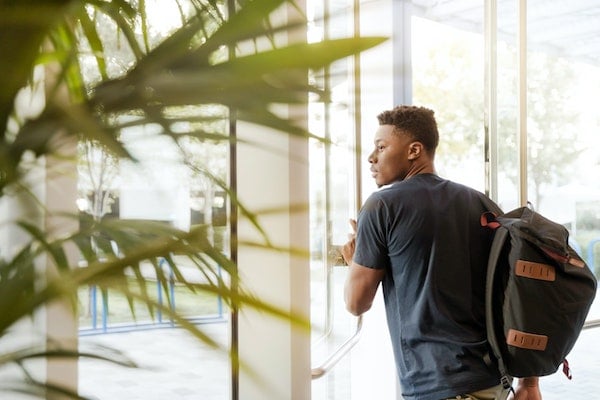Published on
Focusing on Retention Not Recruitment: A Student’s Perspective

Jayden awoke to the patterned vibration she felt on her wrist. Her shift ended just past midnight, and she did her best to get a minimum of six hours of sleep, always craving more. Pressing the side button on her college-provided device and looking at the ceiling above her bed, the cell phone on her nightstand displayed her message alerts as well as her daily schedule. Scrolling through a few messages from her friends and family, she landed on the Broward College App alerts.
“Good Morning Jayden,” said an animated sea hawk appearing above her, following her as she rose and made her way to the bathroom. Projected via augmented reality down the hallway and jumping from her vanity to the smart mirror above the sink, “Sammy the Seahawk” shared Jayden’s schedule for the day from the tip of his wing. “It looks like you’re doing well with your core pathway artifacts, Jayden,” said Sammy, “but let’s see if we can carve out a little time for some tutoring in those math objects that have given you some challenges.” Jayden’s schedule adapted before her, adding a tutoring session between her travel to campus and a scheduled activity at the local lake. “Rashad, Demonica, and Alex would like to meet you today for a quick bite this afternoon,” offered Sammy. Jayden clicked the “delay” button appearing on the mirror as she brushed her teeth, not yet in the frame of mind to decide so early.
“Today, we’ve planned a few virtual breakout sessions for you, Jayden. Based on your progress this term, you’ll meet virtually with your current cohort for your interdisciplinary portfolio and FinTech project. After that, we’ve got you in a stakeholder debate at the Community Learning Pavilion on the main campus. This will be followed by Professor Galbreth leading you and a few other students through an exercise on critical thinking as we continue to tackle that stormwater runoff issue. Here’s a transportation map to use for a visit to City Hall as we engage the commissioners. By the way, I’ve taken the liberty of contacting your employer to change your shift so you can make this late afternoon visit. Is there anything else I can help you with?” closed Sammy.
“Yeah,” said Jayden, “can you move my clock back an hour.” “Sorry,” said Sammy, “Daylight Savings Time ended last month.”
Changes in higher ed are coming
When we envision the future of higher education, our students’ lives, and the vibrancy of our community, we can see significant changes on the horizon like those in Jayden’s life. As we struggle to emerge from a global pandemic in increasingly uncertain times, we know all too well that members in our community not afforded access to or success within higher education will be at extreme disadvantage. At the institutional level, we can indeed adapt on the proverbial fly with great success. In the case of Broward College, our remarkable faculty and college support teams worked together to shift over 4,000 classes to remote modality, preserving 93% of those sections. We did it in ten days, in the middle of a term, achieving just shy of 80% student course success rates by end of term. I’m sure many of you have similar stories of this rapid shift with equal and greater success.
Maintaining attainment excellence
Yet, we all still face levels of excellence in attainment at the 35% or less range in 150% of program time. Sure, life gets in the way. There are many variables impacting why some students persist in our programs and pathways and many do not. Socioeconomic factors remain strong predictors. Equity, diversity, and inclusion have never been more at the forefront of many of our minds amidst continued social injustice. So, where do we focus our energies as state budgets and resources continue to decline for most of us? What genuinely new models and technologies can we explore as we redirect organizational culture and face a fundamental shift in the nature of teaching and learning? How can we leverage such approaches to meet each and every learner where they are at, and not where we might like them to be? What will your colleges, campuses, and communities look like in as few as five years after COVID-19?
Usually, the greater the crisis, the greater the opportunity. At times, such levels of disruption can feel almost like chaos. Some of you may have been fans of the popular series Game of Thrones in which the scheming character Littlefinger is confronted by the astutely political Varys who warns him of the realm’s descent into chaos. Littlefinger defends his actions by observing, “Chaos isn’t a pit. Chaos is a ladder.” “Many who try to climb it fail and never get to try again. The fall breaks them. And some are given a chance to climb, but they refuse. They cling to the realm, or the gods, or love… Illusions. Only the ladder is real, the climb is all there is.”
Emerging from crisis
Today, we face an unprecedented climb in higher education. As we recover from the impact of the COVID-19 pandemic, some of us will refuse the opportunity before us. Others have already been broken. Happily, some of us have embraced this chaos and see the ladder of opportunity it offers—so, we climb it. But where exactly does this ladder lead us? Kim and Maloney (2020) in their recent work, Learning Innovation and the Future of Higher Education acknowledge the uncertainty of this journey, while emphasizing that it will exist somewhere at the intersection of learning, technology, design, and organizational change. What happens in the classroom, they contend, is always a function of many variables outside it.
As we all adjust to a reality of continued uncertainty, we can see something of a light at the end of this tunnel. What’s illuminated on the other side is yet to be seen, a world of shadows and new patterns that has been painted by a shifted assumption. Online and hybridized teaching and learning (no matter what the label) is not likely to be put back in the bottle. Our faculty and their entire support systems have risen to this challenge with stellar marks. Our students have proven that they can succeed at comparable rates in what may be the direst of circumstances. We are all left wondering what will come of these events. Will this continued acceleration and expansion of innovation be the new norm? How will our fiscal models adjust over time? What will this mean for traditional roles and responsibilities throughout our systems? Perhaps there is a framework here that we can look to better process this situation and to continue our climb.
In the coming weeks I hope you can join me and the EvoLLLution community as we all move forward. If you see this evolution, from recruiting to retention, challenging every higher education institution to address its core culture in post-pandemic economic recovery, you may enjoy this discourse. Key points in this article series for leaders will be:
- The New Dimensions of Scholarship: Shifting faculty development from morbidity models to students success predictive analytics
- The Journey to Fusion Teaching: Evolving traditional class scheduling to individualized optimization at the learning object level
- The Emerging Helix Curriculum: Merging liberal arts and career and technical education toward the future of work
- Creating and Sustaining Regional Talent Ecosystems in a Complex Molecular Economy: A new pathway focused on retention
Whatever your vision for our college in 2030 and beyond, artificial intelligence, BlockChain, deep analytics, near-field communication and a host of other technologies are only some of the advancements that merit exploration alongside the even more complex human issues of shifting assumptions and organizational cultures across higher education and the sea of stakeholders we serve.
“Congratulations Jayden,” chirped Sammy as Jayden tapped the incoming message at the end of her long day. “You’ve reached your program’s 25% milestone!” Pictures of her advocates swirled around the icons now dancing across the wall of her tiny apartment. Professors, adjuncts, advisors, college foundation members, her current employer, fellow students, and Jayden’s mom appeared. The word cloud before her grew with messages of encouragement, inspiration, and motivation. Major companies’ logos and regional prospective employers in her degree pathway offered clickable rewards. Jayden tapped one, sharing details of a scheduled company site visit and internship. “Maybe I’ll just start my own business,” she thought. The background music began to fade as she clicked the Dunkin Donut’ icon and accepted her free coffee token and fell asleep.
Disclaimer: Embedded links in articles don’t represent author endorsement, but aim to provide readers with additional context and service.
Author Perspective: Administrator



